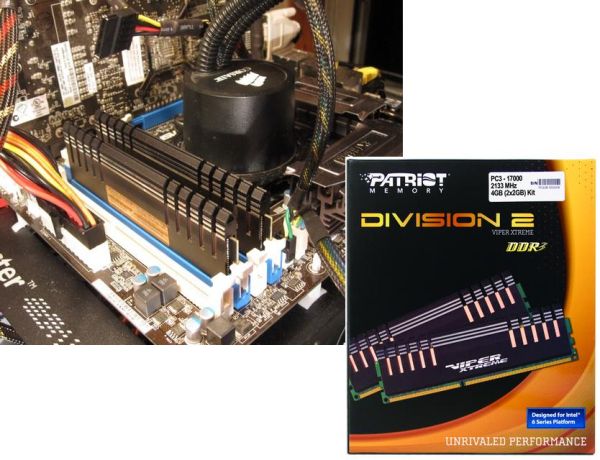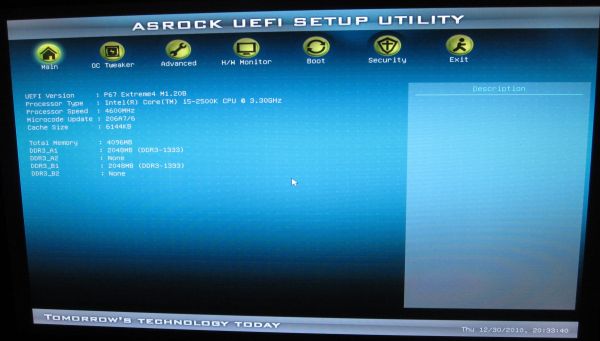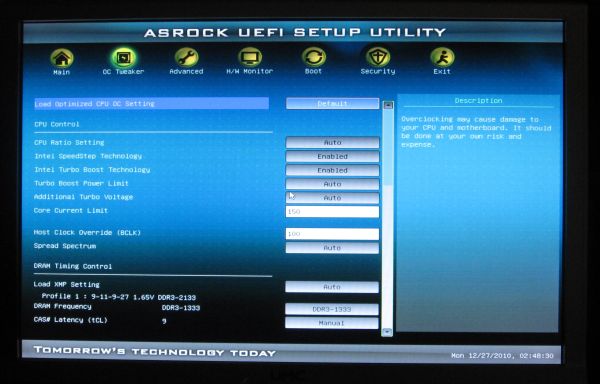Welcome to Sandy Bridge, with the ASRock P67 Extreme4
by Ian Cutress on January 3, 2011 7:00 AM EST- Posted in
- Motherboards
- ASRock
Test Setup
| Processor |
Intel i5-2500K ES—3.3GHz (3.7GHz Turbo) 4 Cores, 4 Threads, 6MB L3 |
| Motherboards | ASRock P67 Extreme4 |
| Cooling | Corsair H50-1 Water Cooler |
| Power Supply | Enermax Modu87+ 600W 80PLUS |
| Memory |
Patriot Viper Xtreme DDR3-2000 9-10-9-27 2x4GB Kit, 1.65V Patriot Viper Xtreme Division 2 DDR3-2133 9-11-9-27 2x2GB Kit, 1.65V |
| Memory Settings | Patriot Viper Xtreme Division 2 2x2GB @ DDR3-1333 9-9-9-27 |
| Video Cards | XFX HD 5850 1GB |
| Video Drivers | Catalyst 10.12 |
| Hard Drive | Intel X25-M 80GB SSD Gen2 |
| Optical Drives | LG GH22NS50 |
| Case | Open Test Bed—CoolerMaster Lab V1.0 |
| Operating System | Windows 7 64-bit |
| USB 2/3 Testing | Patriot 64GB SuperSonic USB 3.0 |
Each motherboard received a fresh operating system install before testing and benchmarking. For multi-GPU comparisons, dual XFX HD5850 GPUs at stock clocks were used with Catalyst 10.12 drivers. Memory is set at DDR3-1333 C9 to allow comparison to future H67/H61 motherboards.
Many thanks to Patriot Memory for sending their Viper Xtreme DDR3 kits to use in reviews. The 2x4GB kit, specifically for dual-channel operation, is rated at 2000MHz, CAS 9-10-9-27 at 1.65V and retails for $175. The 2x2GB Division 2 kit, also for dual-channel, is a newly released part by Patriot, specifically for P67, and runs at 2133MHz, CAS 9 11-9-27 at 1.65V. I am informed that this kit will retail for around $100.
Another comparison point for this review is an X58, socket 1366 system, based on the ASRock Extreme3 board that I reviewed in 2010. Quite a lot of people will have invested in an X58 system over the past twelve months, in the pursuit of performance, and it will be interesting to see how the stock i7-920 processor, and the P67 systems with the i5-2500K processor, compares.
| Test Setup | ||
| Processor |
Intel i7-920 d0—2.67GHz (2.93GHz Turbo) 4 Cores, 8 Threads, 8MB L3 |
|
| Motherboards | ASRock X58 Extreme3 | |
| Cooling | Akasa Nero | |
| Power Supply | Enermax Modu87+ 600W 80PLUS | |
| Memory | Corsair Vengeance DDR3-1600 9-9-9-24 3x4GB Kit, 1.50V | |
| Memory Settings | Corsair Vengeance DDR3-1333 9-9-9-24 3x4GB | |
| Video Cards | XFX HD 5850 1GB | |
| Video Drivers | Catalyst 10.12 | |
| Hard Drive | Samsung PB22-J SSD 60GB | |
| Optical Drives | LG GH22NS50 | |
| Case | Open Test Bed—CoolerMaster Lab V1.0 | |
| Operating System | Windows 7 64-bit | |
The results for other P67 motherboards are included also in this review to provide points for comparison. Full reviews for these boards will be published shortly. A note on the Gigabyte P67A-UD4 board - the latest BIOS at time of writing (F5) seems to have issues with its Turbo mode, resulting in a 1x multiplier increase rather than the expected 4x when one core is active. As such, results from the UD4 in single threaded benchmarks may be lower than expected. These results will be updated if the BIOS is fixed by the time that review is published. Update: The F7 Beta BIOS for the UD4 implements turbo correctly - the graphs have been updated.
UEFI
One of the main features of the Sandy Bridge platform is the new BIOS interface, the Unified Extensible Firmware Interface (UEFI). Almost everything about the UEFI is similar to the BIOS system of old—the menus and the options are identical. The only difference is the GUI—we now get colors and images (which I can see getting more elaborate as the system grows in time), and the use of the mouse. Each vendor's UEFI implementation will be visually quite different, if they've implemented it at all.
Initially, you will find that in the Extreme4 UEFI, the mouse wheel does not work. This is not a massive deal-breaker, by any means. I still prefer using the keyboard to navigate all the options, and I had no issues in using the arrow keys. You can’t use the number pad to put in voltages and such, which would be a nice touch.
The main menu option of choice is the optimized CPU OC setting. In general, it is best not to trust this option on any motherboard, but ASRock have done a good job here. It offers auto-overclocking settings from 4.0GHz to 4.8GHz in 0.2GHz steps, which as I’ll talk about below, the 4.6GHz setting is the preferential setting for our 24/7 overclock.
The CPU multiplier and BCLK are fully adjustable. The memory timings are linked for every memory stick in the board—as this isn’t the highest end board, we didn’t expect the ability to set every channel independently. The board also allows saving up to three profiles, and OC recovery worked when we overclocked to 5GHz while setting a low voltage.
One thing of note is that the ASRock UEFI version 1.20B sets the BLCK over the 100MHz standard. ASRock have set this at 100.4MHz (even though this isn’t visible in the UEFI, only in the OS), meaning that they hope to gain a 0.4MHz BCLK advantage over other manufacturers at stock speed. We experienced no instability due to this, so we will see how this affects the results against other motherboards.
As a first go, the ASRock UEFI interface isn't radically different, but it works well. We're more interested in seeing the UEFI system enhancements over the coming months! It opens up a lot of new options if anyone puts the necessary effort into it, so we could see some very cool additions down the road.



















55 Comments
View All Comments
Mazlov - Tuesday, January 4, 2011 - link
Having read all the SB articles on AT, I must admit that I too feel that this platform is getting a bit more attention than it deserves. I suspect this is because X58 has been around for such a long time, and enthousiasts are eag to get their hands on something new.In reality, SB, although providing us with a very decent performance upgrade, is not all that exciting. IPC does not seem to have improved very much. Much of the improvement seems to be realized by the higher stock clocks and excellent Turbo. Both of which are a direct result of the new 32nm production process.
The thing that realy bothers me though, is that the chipsets look as if it's still 2009. With the exception of sata-600, nothing about the SB platform is particularly modern. No onboard usb3, not a trace of Light Peak (while Apple is rumoured to have it on Macs this year), no pci-e 3.0 (understandable since it has only rercently been finalized). Looks to me as if Intel is indeed hostage of their own time schedule.
To make matters even worse. Intel has taken their market segmentation one step further, by increasing the amount of different chipsets. All with their own limitations.
Now I'm not saying that SB is a bad product. For over ninety percent of consumers it will fit perfectly. Whether it is good enough for us enthousiasts... I doubt it. 2011 will see some interesting new technologies and SB sadly does not seem to support them yet. If you are a hardware enthousiast, unless you are willing to upgrade again at the end of this year, SB is not for you.
mapesdhs - Wednesday, January 5, 2011 - link
Two 8X PCIE is more than sufficient for SLI/CF with the vast majority of games/apps
using anything other than perhaps the highest end GPUs. naturally X58 favours 3-way/4-way CF/SLI, but few games benefit significantly from these modes (to the
extent that the entire additional platforum cost is worthwhile) and some games perform
worse.
Likewise, dual-channel RAM is also plenty, especially since unlike X58 the
P55 platform does not suffer from the 'vanishing' RAM channel problem when overclocking.
However, I do agree that X58 is hardly dead for those who've bought them. Very
few users will really *need* the extra speed offered by SNB CPUs, and all those
with 920/930 CPUs have the 6-core options which will come down in price.
But don't claim that dual 16X PCIE and 3-channel RAM is essential for high
performance because that's just plain wrong. With the help of a friend who has
an i7 930 system with two GTX 460 SLI, I've accumulated a plethora of benchmark
results which show what I mean (my system is an i7 870 @ 4270MHz, dual EVGA
GTX 460 1GB FTW SLI). Google for "3DMark06 Benchmark SGI Depot", see the
end of the page for the URLs of the other _nine_ pages of performance results,
more added daily/weekly when I & my friend are able.
QED.
Ian.
jp9700 - Monday, January 3, 2011 - link
I just wanted to thank you for including your "3D Movement" benchmark. I do a fair amount of computational chemistry myself (although generally quantum mechanics), and I find it incredibly hard to find applicable benchmarks on new hardware.jimhsu - Monday, January 3, 2011 - link
Seconded ... most of the scientific community is notoriously conservative when it comes to publishing relevant benchmarks for scientific applications on new hardware. Often, the best you can do is hear from a colleague that "Lab X upgraded to Y and got good results" or "Dr. A. (who published in Nature, Cell, Science, whatever) has 10K in grant money and bought that, so we should too". On rare cases you might see an anecdotal report on a group's public website that tests a single config against another particular configuration and shows a % improvement ... those are rare though.DesktopMan - Monday, January 3, 2011 - link
When are they getting rid of the Realtek hardware? The Realtek audio drivers have given me nothing but trouble for years. Isn't there support for gbit ethernet in the platform as well, but board manufacturers choose not to use them? Remember reading about that last bit but not entirely sure if I remember correctly.wolfman3k5 - Monday, January 3, 2011 - link
When something CHEAPER and BETTER will come along. And if you're complaining about Realtek, well, do you remember the old audio codecs that where used in the past before Realtek?dgobe - Monday, January 3, 2011 - link
It would be nice to see an i7 920(OC'd) vs an i7 2600K at the same clock speed. Turbo off, just to see how the two architectures compare.wolfman3k5 - Monday, January 3, 2011 - link
You won't see that because the idea is to throw out the old and buy new. Line your pockets people, in a couple of days you'll be able to buy shiny new toys at newegg.com. As for everyone else, keep and eye on eBay for tons of cheap used CPUs and Mobos.landerf - Monday, January 3, 2011 - link
About the bandwidth (muti 3d test), while clock for clock yes 1155 only beats 1156, at max speed it should pass or match 1366 as 1366 is speed limited. That's why I bought 8 gbs of 2400mhz ram in prep for sandy.GTVic - Monday, January 3, 2011 - link
I've seen very little information on UEFI, do some Sandy Bridge motherboards have a BIOS or do they all have UEFI.Also, this motherboard has two PS2 ports and a floppy connector. I have seen several Sandy Bridge motherboards which have no IDE, no floppy, no serial/parallel ports and only one blue/green PS2 port. So this motherboard seems to be catering to people with legacy requirements. I think the need for a floppy connector is overstated.